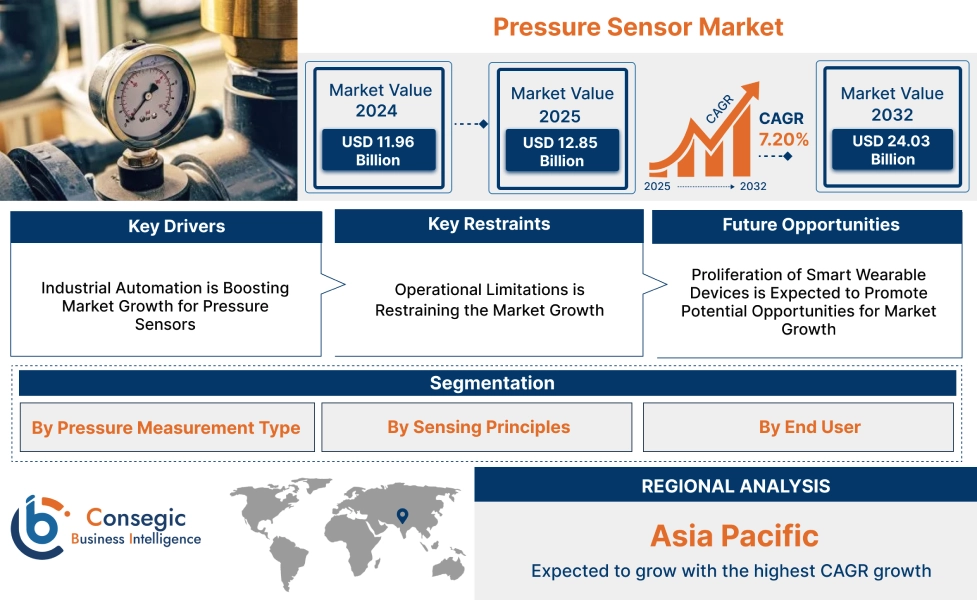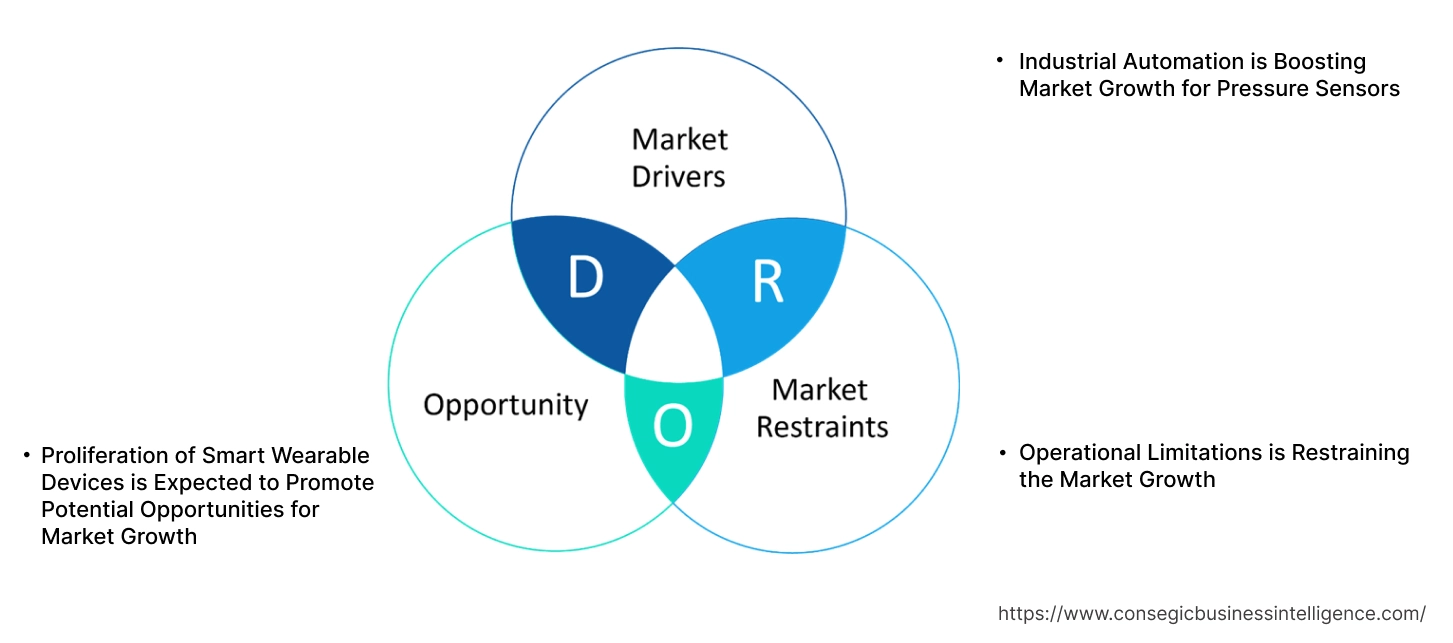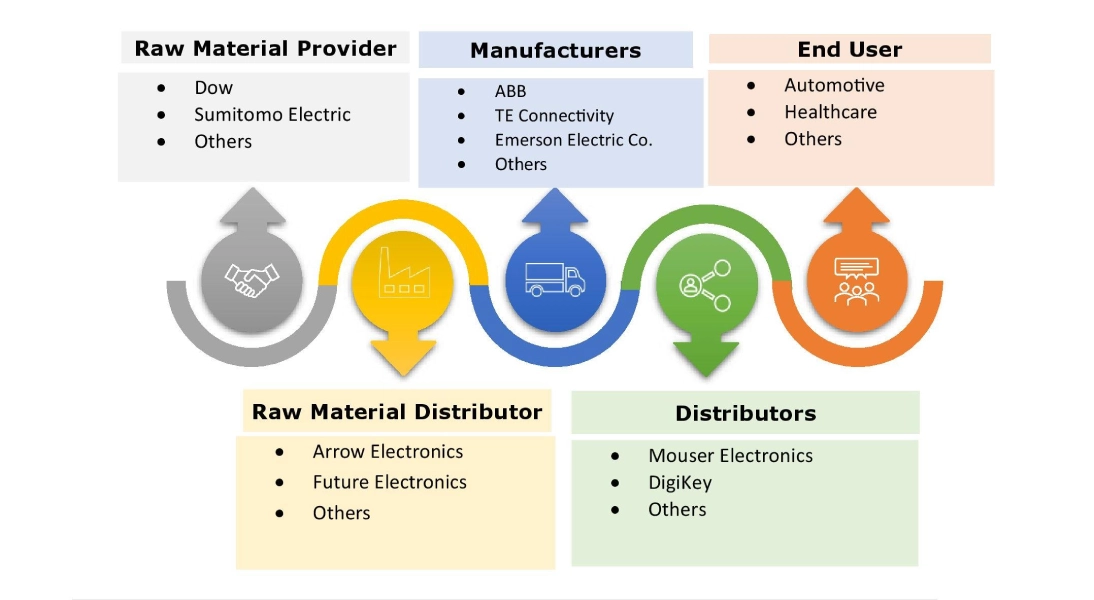Pressure Sensor Market Size:
Pressure Sensor Market size is estimated to reach over USD 24.03 Billion by 2032 from a value of USD 11.96 Billion in 2024 and is projected to grow by USD 12.85 Billion in 2025, growing at a CAGR of 7.20% from 2025 to 2032.
Pressure Sensor Market Scope & Overview:
A pressure sensor is a device that detects and measures the force exerted on the surface and converts that force into an electrical signal. These signals are utilized to monitor, control, or display pressure readings in various applications. Additionally, the key types of sensors include absolute, gauge, and differential for measurement of pressure. Moreover, the key advantages, including improved safety, process control, and energy efficiency, are driving the pressure sensor market demand. Further, the sensors are essential for monitoring and controlling pressure in systems, preventing equipment failures, and optimizing performance, which in turn is fueling the pressure sensor market growth. Furthermore, the stringent government regulations related to safety and security across industries are boosting the pressure sensor industry.
How is AI Transforming the Pressure Sensor Market?
AI is transforming the global pressure sensor market by making sensors smarter, more responsive, and efficient. By leveraging machine learning, AI enhances sensor accuracy through real-time calibration, adjusting to environmental changes like temperature and vibration. This leads to more precise pressure readings across industries ranging from automotive to healthcare. AI also enables intelligent diagnostics, detecting sensor drift or anomalies early and reducing downtime. In industrial settings, AI-driven analytics predict maintenance needs and optimize system performance. Additionally, AI facilitates sensor fusion by combining pressure data with other sensor inputs for better insights and decision-making. As the demand grows for high-performance and reliable pressure sensing, AI is accelerating innovation and driving broader adoption worldwide.
Pressure Sensor Market Dynamics - (DRO) :
Key Drivers:
Industrial Automation is Boosting Market Growth for Pressure Sensors
The sensors provide real-time data on pressure variations in machinery and systems, enabling continuous monitoring and control of processes. Additionally, the integration of sensors into automated systems optimizes processes, improves product quality, and enhances overall productivity, which in turn is fueling the pressure sensor market demand. Further, industries are increasingly adopting automated systems, and smart manufacturing practices are driving the pressure sensor market growth.
- For instance, in January 2024, Sensata launched the 129CP series digital water pressure measuring sensor, aiming to enhance smart pressure monitoring capabilities to water utilities and drive waste reduction at commercial and residential buildings.
Therefore, the growing adoption of industrial automation is driving the need for sensors, in turn, proliferating the growth of the market.
Key Restraints:
Operational Limitations is Restraining the Market Growth
The environmental factors, such as temperature and humidity, which impact their accuracy and reliability, are hindering the pressure sensor market expansion. Additionally, some sensors are designed with specific environmental considerations, which in turn require compensation or calibration to maintain accurate readings in harsh conditions is restraining the market adoption. Further, the thermal expansion and contraction of the sensor components, or changes in the electrical properties of the sensing element due to high temperature, are hindering the market adoption in various industries.
Therefore, the aforementioned environmental factors are hindering the pressure sensor market expansion.
Future Opportunities :
Proliferation of Smart Wearable Devices is Expected to Promote Potential Opportunities for Market Growth
Smart wearables, including smartwatches, fitness trackers, and smart clothing, are becoming more sophisticated, with enhanced functionality and integration of advanced sensors, such as pressure sensors and others are propelling the pressure sensor market opportunities. Additionally, the sensors are integrated into sports equipment and clothing to monitor athletic performance, track movement patterns, and provide real-time feedback to athletes. Further, the integration of AI and IoT technologies with smart wearables is enhancing their functionality, and personalization is boosting the market progress.
- For instance, according to IBEF, India manufactured USD 194.97 million worth of wearable devices such as earphones and smartwatches in FY2022-23, as well as shipped 37.2 million units in Q3FY22, which in turn is driving the market adoption.
Hence, the rising adoption of wearable devices is anticipated to increase the utilization of sensors, in turn promoting prospects for pressure sensor market opportunities during the forecast period.
Pressure Sensor Market Segmental Analysis :
By Pressure Measurement Type:
Based on the pressure measurement type, the market is segmented into absolute, gauge, and differential.
Trends in the Pressure Measurement Type:
- The integration with AI and ML for advanced data analysis is driving the adoption of absolute sensors, thereby boosting the pressure sensor market trends.
- The differential wireless pressure measurement sensors are gaining traction, as they offer greater flexibility and ease of installation is fueling the pressure sensor market trends.
Gauge accounted for the largest revenue share in the year 2024.
- Gauge sensors are mainly utilized in the automotive and industrial automation sector.
- Additionally, the pressure measurement sensors are crucial in tire pressure monitoring systems, engine control units, and other automotive applications are driving the pressure sensor market share.
- Moreover, urbanization in developing countries is boosting the demand for pressure sensors in various applications, which in turn boosts the pressure sensor market size.
- Further, the rise of Industry 4.0 and IoT is driving the adoption of sensors for predictive maintenance, and remote monitoring in smart manufacturing is driving the pressure sensor market share.
- Thus, as per the pressure sensor market analysis, the rise of Industry 4.0 and IoT is driving the market progress.
Absolute is anticipated to register the fastest CAGR during the forecast period.
- An absolute pressure measurement type has the ability to measure the total force exerted by a fluid or gas, including atmospheric pressure.
- Additionally, advancements in MEMS technology and the expanding applications in automotive, healthcare, and consumer electronics sectors are driving the adoption of the absolute segment.
- Further, the key factors shaping the progress of absolute sensors include miniaturization, wireless capabilities, and integration with AI and machine learning is boosting the pressure sensor market size.
- For instance, in April 2025, Kistler launched an absolute pressure measurement sensor to measure hydrogen pressure in fuel cells. Also, the measurement range of the sensor is up to 20 bar and 50 bar.
- Therefore, as per the market analysis, the aforementioned factors are anticipated to boost the market during the forecast period.
By Sensing Principles:
Based on the sensing principles, the market is segmented into resistive, capacitive, piezoelectric, optical, MEMS, and others.
Trends in the Sensing Principles:
- Increasing adoption of resistive pressure sensing devices, due to its several benefits, including high precision, robustness, and stability, among others.
- Rising utilization of capacitive pressure sensing devicesdue to its high sensitivity, low power consumption, good repeatability, and improved tolerance to temperature changes is driving the market trends.
Resistive segment accounted for the largest revenue share in the overall market in 2024.
- Resistive pressure measurement sensors are designed to measure pressure by detecting changes in electrical resistance of a material when it is subjected to stress or strain. This change in resistance is proportional to the applied pressure, which makes it an ideal method for pressure measurement.
- Moreover, these sensors often utilize strain gauges, which are bonded to a diaphragm that deforms under pressure, causing a change in the gauge's resistance. The change in resistance can then be converted into pressure reading.
- Moreover, resistive pressure sensing devices offerseveral benefits, including high precision, robustness, and stability, which makes them ideal for a wide range of industrial applications.
- For instance, Bosch Sensortec GmbHoffers pressure measurement sensors that work with the piezo resistive principle in its product offerings. The sensors are designed for use in several wearables, smartphones, and smart home applications, among others.
- According to the market analysis, the rising advancements associated with resistive pressure sensing devicesare driving the market growth.
The capacitive segment is anticipated to register the fastest CAGR during the forecast period.
- A capacitive pressure measurement sensor measures pressure by detecting changes in capacitance caused by the displacement of a diaphragm.
- In capacitive pressure sensing devices, a diaphragm acts as one plate of a capacitor, and its movement in response to pressure changes the capacitance of the circuit. This change in capacitance is further measured to determine the applied pressure.
- Moreover, it offers several benefits, including high sensitivity, low power consumption, good repeatability, and improved tolerance to temperature changes and overpressure.
- For instance, Murata Manufacturing Co. Ltd. offers capacitive sensing-based pressure sensors in its product portfolio, which offers several benefits such as low noise, lower current consumption, and good stability for temperature change.
- Thus, the rising developments associated with capacitive pressure sensing devicesare expected to boost the market during the forecast period.
By End User:
Based on the end user, the market is segmented into consumer electronics, automotive, healthcare, energy & power, aerospace & defence, oil & gas, manufacturing, and others.
Trends in the End User:
- Factors including rising automobile production, increasing trend of electric vehicle (EV) adoption, and advancements in autonomous vehiclesare driving the automotive segment.
- Factors such as increasing adoption of smartphones and other consumer devices, advancements in consumer electronics, including internet of things(IoT) and artificial intelligence, along with rising popularity of wearable devices are key trends driving the consumer electronics segment.
Automotive segment accounted for the largest revenue share of 21.24% in the market in 2024.
- Pressure measurement sensors play a crucial role in the automotive industry for monitoring and regulating various vehicle systems, including engine performance, fuel delivery, braking, and tire pressure. This contributes to improved vehicle efficiency and overall driving experience.
- Moreover, these sensors are used for providing real-time pressure data, which further enables the vehicle's control systems to optimize performance and ensure safe operation.
- For instance, according to the International Organization of Motor Vehicle Manufacturers, the total production of passenger cars in Europe reached up to 15,449,729 units in 2023, representing an increase of nearly 13% in comparison to 2022.
- Consequently, the rising automotive production is driving the adoption of these sensors, in turn propelling the market growth.
The healthcare segment is anticipated to register the fastest CAGR during the forecast period.
- Pressure measurement sensors play a crucial role in a wide range of healthcare applications, involving monitoring patient conditions, guiding treatments, and various medical devices.
- They are used for measuring pressure in gases and liquids, in turn ensuring accurate delivery of therapies and providing essential data for diagnosis and treatment.
- Moreover, these sensors are primarily used in healthcare applications, including respiratory support systems, blood pressure monitoring systems, and other medical devices.
- For instance, Setra Systems offers a broad range of pressure measurement sensors, including Model AXD, Model 210, and others, which are specifically designed for use in medical devices. These sensors feature a robust design and high accuracy, which further enables improved performance of medical devices.
- According to the analysis, the rising adoption of pressure sensing devices in healthcare sector is projected to drive the market during the forecast period.
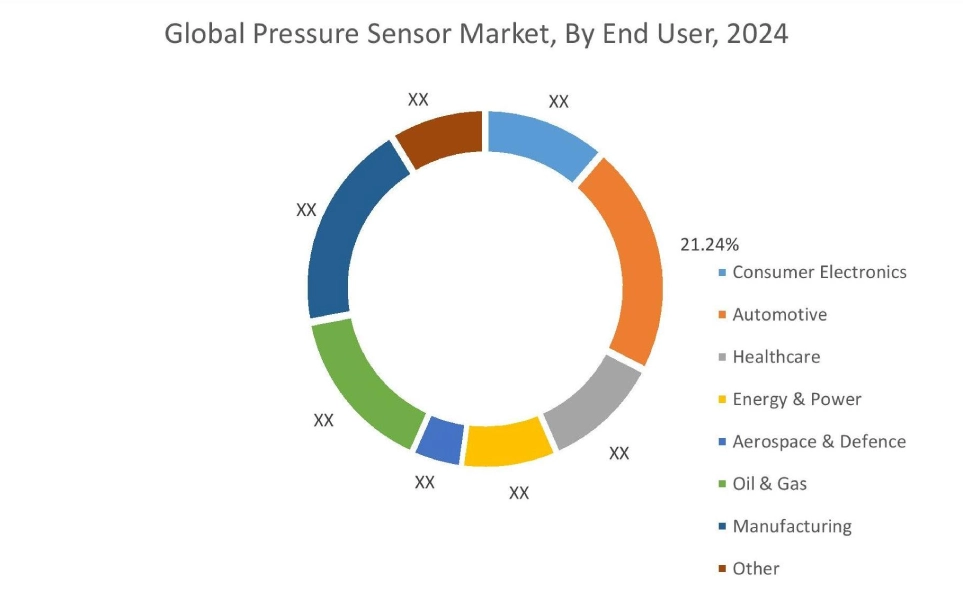
Regional Analysis:
The regions covered are North America, Europe, Asia Pacific, Middle East and Africa, and Latin America.
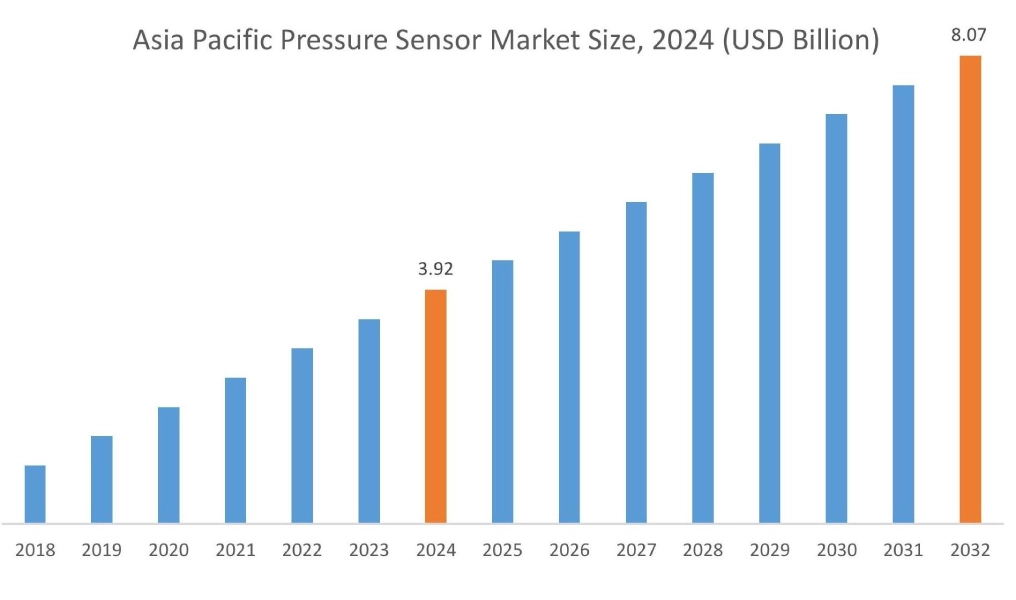
Asia Pacific region was valued at USD 3.92 Billion in 2024. Moreover, it is projected to grow by USD 4.21 Billion in 2025 and reach over USD 8.07 Billion by 2032. Out of this, China accounted for the maximum revenue share of 32.34%. As per the pressure sensor market analysis, the adoption of pressure sensing devices in the Asia-Pacific region is primarily driven by the growing manufacturing, consumer electronics, and automotive sectors, among others. Additionally, the rising production of consumer electronic devices is further driving the market in the Asia-Pacific region.
- For instance, according to the India Brand Equity Foundation, the value of consumer electronics and appliances industry in India reached up to USD 9.84 billion in 2021, and it is projected to grow at a substantial rate to reach USD 21.18 billion by 2025. Therefore, the above factors are further driving the market demand in the Asia-Pacific region.
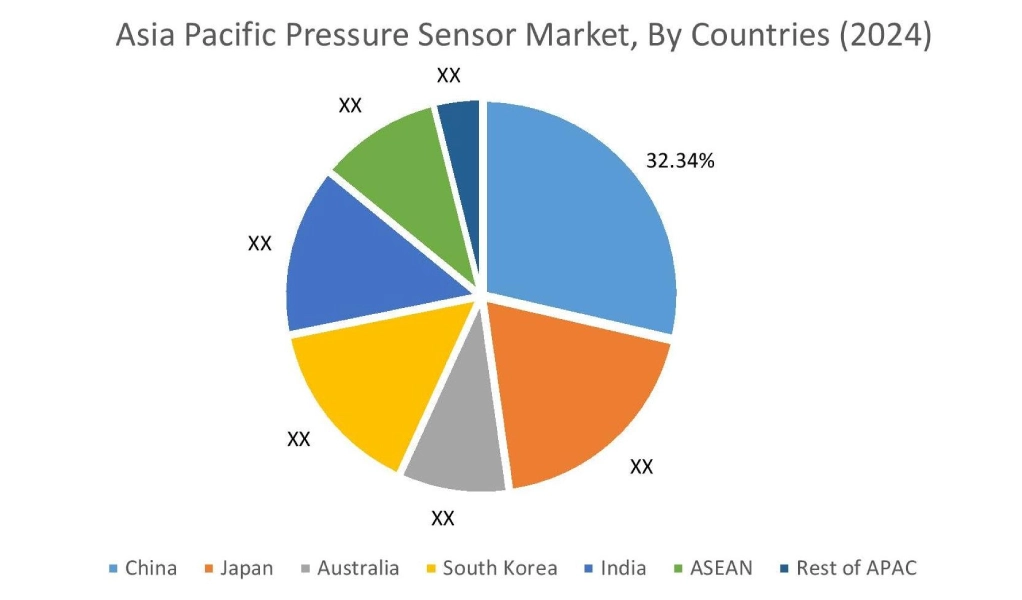
North America is estimated to reach over USD 6.86 Billion by 2032 from a value of USD 3.39 Billion in 2024 and is projected to grow by USD 3.64 Billion in 2025. In North America, the market is mainly driven by growing aerospace & defense, automotive, healthcare, and other industrial sectors. Moreover, the increasing manufacture of automotive vehicles and aircraft is contributing to the market demand.
- For instance, according to the International Organization of Motor Vehicle Manufacturers, the overall automobile production in North America reached 16.16 million in 2023, witnessing an increase of 9.3% from 14.79 million in 2022. The above factors are projected to boost the market in North America during the forecast period.
Similarly, the regional analysis depicts that the increasing production of aircraft, rising investments in electric vehicle manufacturing, and substantial advancements in medical devices are driving the market in Europe. Additionally, according to the market analysis, the market in Latin America, Middle East, and African regions is expected to grow at a substantial rate due to factors such as rising automotive production, growing investments in aerospace & defense sector, development of oil & gas facilities, and others.
Top Key Players and Market Share Insights:
The global pressure sensor market is highly competitive with major players providing sensors to the national and international markets. Key players are adopting several strategies in research and development (R&D), product innovation, and end user launches to hold a strong position in the pressure sensor industry. Key players in the pressure sensor market include-
- Zhengzhou Winsen Electronics Technology Co., Ltd.(China)
- Balluff Automation India Pvt. Ltd.(India)
- Baker Hughes (UK)
- AlphaSense (USA)
- Murata Manufacturing Co., Ltd. (Japan)
- Honeywell International Inc(USA)
- ABB (Switzerland)
- TE Connectivity (Switzerland)
- Emerson Electric Co. (USA)
- Robert Bosch GmbH (Germany)
- Siemens AG (Germany)
Recent Industry Developments :
Product launches
- In May 2025, Kistler launched cylinder pressure measurement sensors for reducing CO₂ emissions, designed for large engines, paving the way for achieving companies' net-zero emissions by around 2050.
Pressure Sensor Market Report Insights :
| Report Attributes | Report Details |
| Study Timeline | 2019-2032 |
| Market Size in 2032 | USD 24.03 Billion |
| CAGR (2025-2032) | 7.20% |
| By Pressure Measurement Type |
|
| By Sensing Principles |
|
| By End User |
|
| By Region |
|
| Key Players |
|
| North America | U.S. Canada Mexico |
| Europe | U.K. Germany France Spain Italy Russia Benelux Rest of Europe |
| APAC | China South Korea Japan India Australia ASEAN Rest of Asia-Pacific |
| Middle East and Africa | GCC Turkey South Africa Rest of MEA |
| LATAM | Brazil Argentina Chile Rest of LATAM |
| Report Coverage |
|
Key Questions Answered in the Report
How big is the pressure sensor market? +
The pressure sensor market size is estimated to reach over USD 24.03 Billion by 2032 from a value of USD 11.96 Billion in 2024 and is projected to grow by USD 12.85 Billion in 2025, growing at a CAGR of 7.20% from 2025 to 2032.
Which segmentation details are covered in the pressure sensor report? +
The pressure sensor report includes specific segmentation details for pressure measurement type, sensing principles, end user, and regions.
Which is the fastest segment anticipated to impact the market growth? +
In the pressure sensor market, the absolute pressure measurement type is the fastest-growing segment during the forecast period due to the miniaturization, wireless capabilities, and integration with AI and machine learning.
Who are the major players in the pressure sensor market? +
The key participants in the pressure sensor market are Zhengzhou Winsen Electronics Technology Co., Ltd. (China), Balluff Automation India Pvt. Ltd. (India), Honeywell International Inc (USA), ABB (Switzerland), TE Connectivity (Switzerland), Emerson Electric Co. (USA), Robert Bosch GmbH (Germany), Siemens AG (Germany), Baker Hughes (UK), AlphaSense (USA), Murata Manufacturing Co., Ltd. (Japan), and others.
What are the key trends in the pressure sensor market? +
The pressure sensor market is being shaped by several key trends including the integration with AI and ML for advanced data analysis, as well as rising automobile production.
